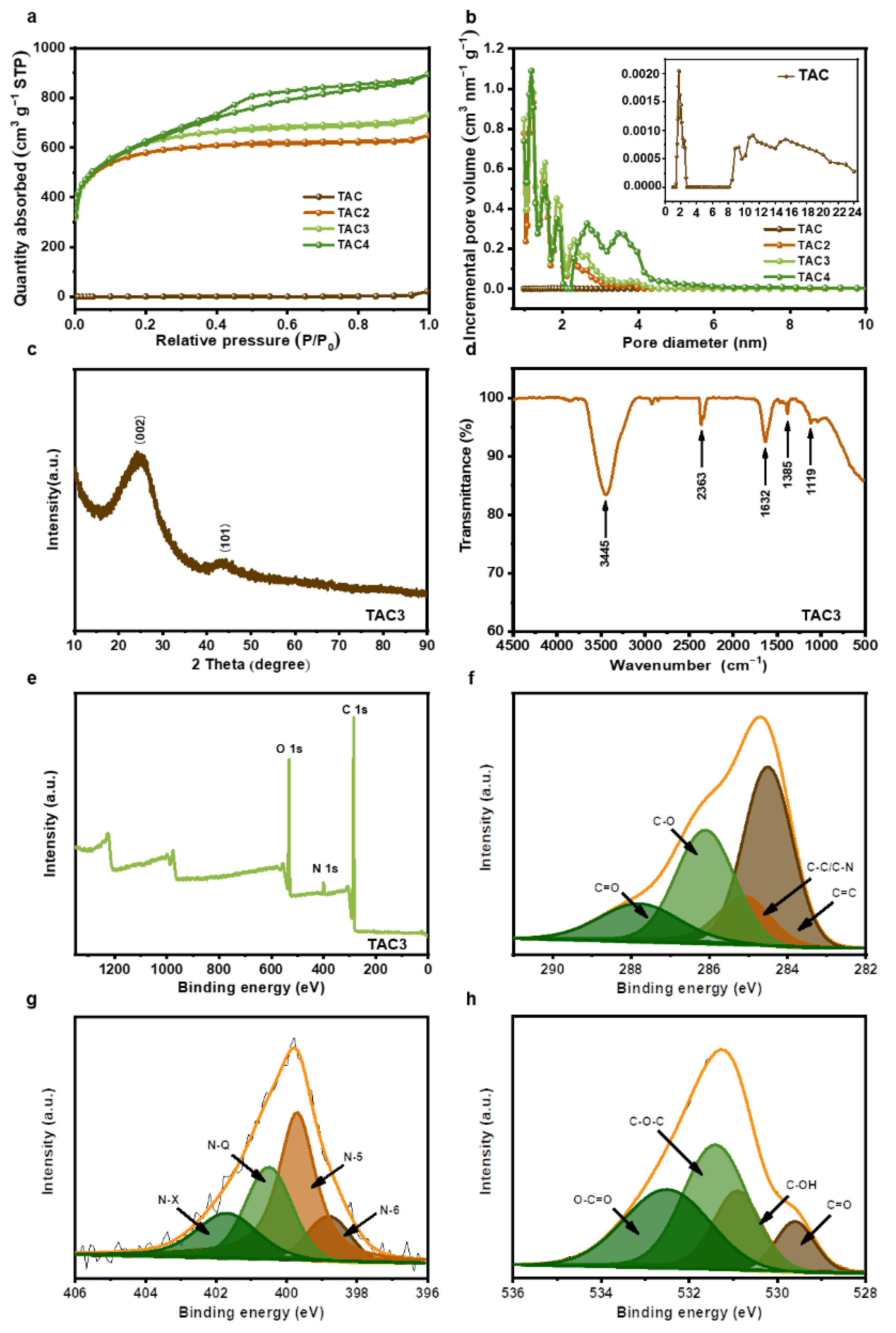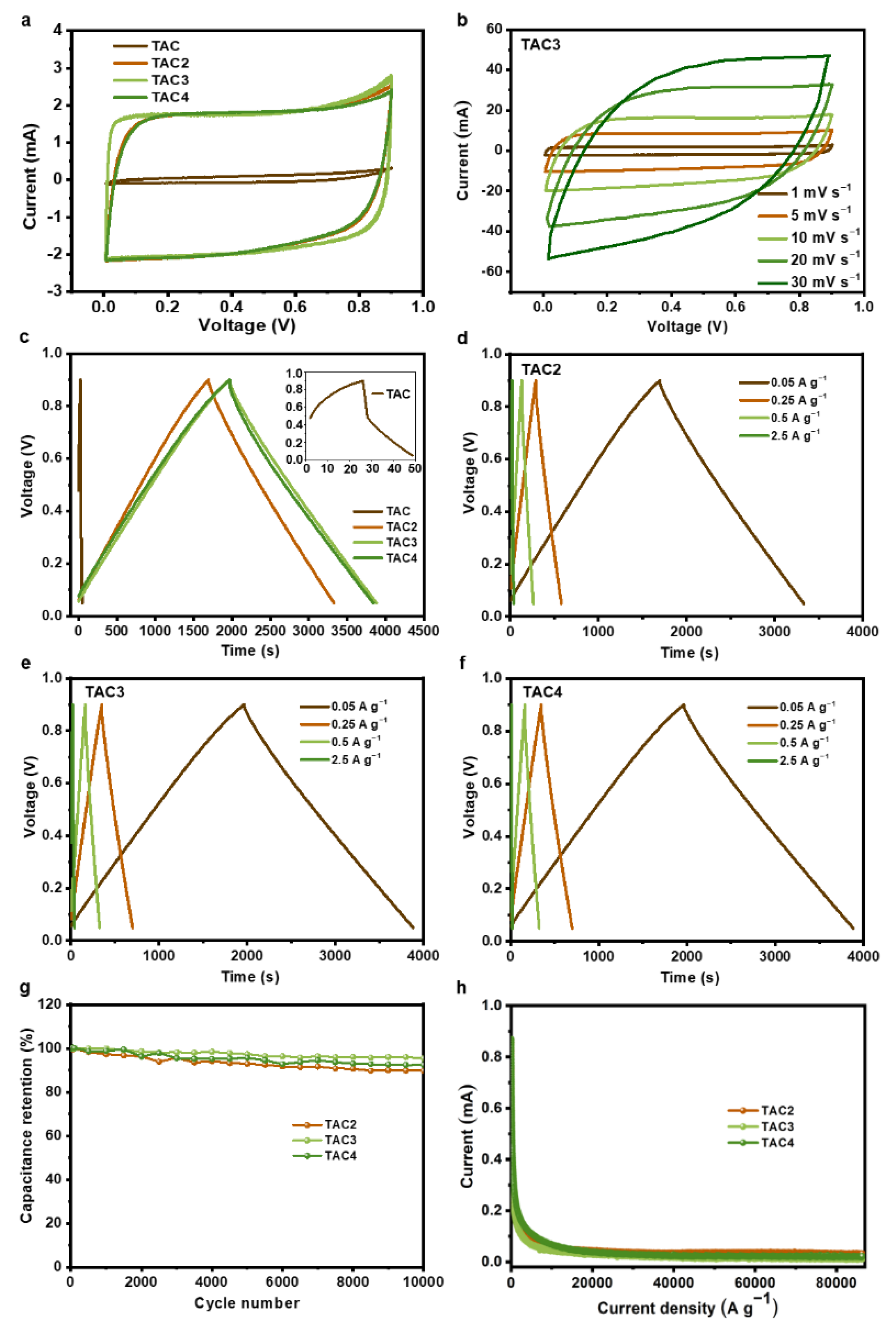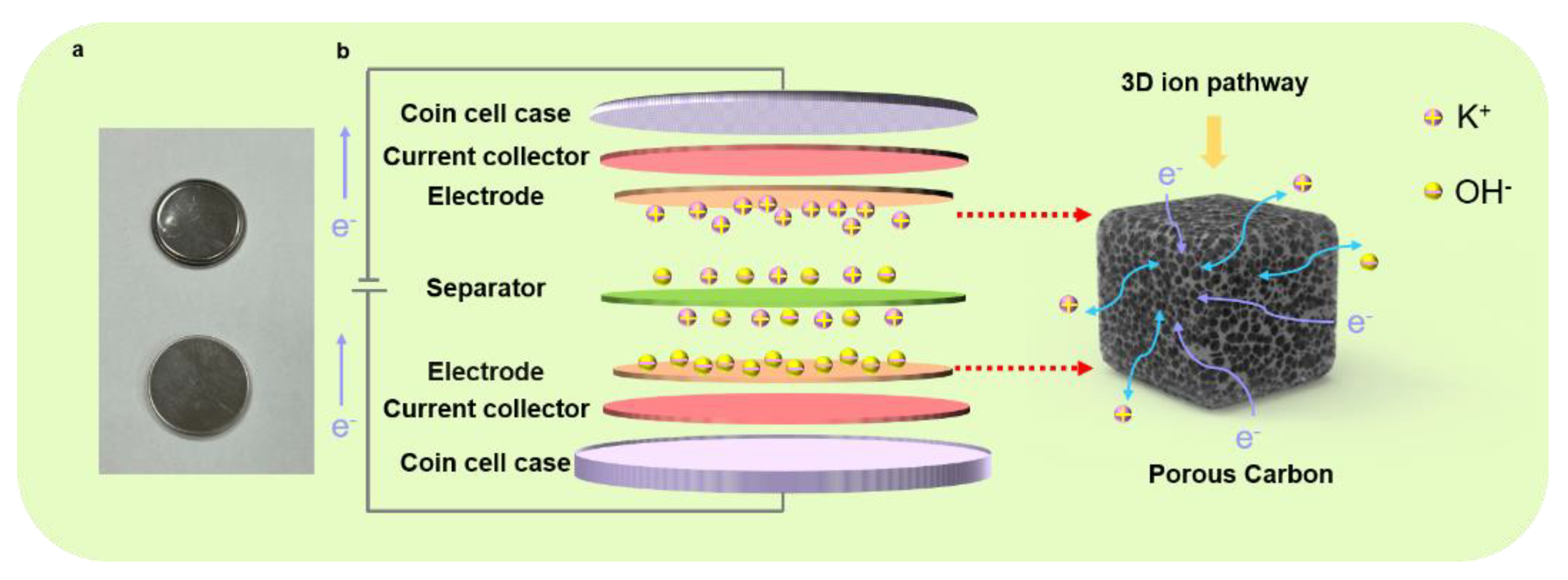A Simple Route to Produce Highly Efficient Porous Carbons Recycled from Tea Waste for High-Performance Symmetric Supercapacitor Electrodes
Abstract
:1. Introduction
2. Materials and Methods
2.1. Materials
2.2. Preparation of ACs
2.3. Characterization
2.4. Electrochemical Measurements
3. Results and Discussion
4. Conclusions
Author Contributions
Funding
Institutional Review Board Statement
Informed Consent Statement
Data Availability Statement
Conflicts of Interest
References
- Chatterjee, D.P.; Nandi, A.K. A review on the recent advances in hybrid supercapacitors. J. Mater Chem. A 2021, 9, 15880–15918. [Google Scholar] [CrossRef]
- Lai, C.; Cheng, L.; Sun, Y.; Lee, K.; Lin, B. Alkaline aqueous rechargeable Ni-Fe batteries with high-performance based on flower-like hierarchical NiCo2O4 microspheres and vines-grapes-like Fe3O4-NGC composites. Appl. Surf. Sci. 2021, 563, 150411. [Google Scholar] [CrossRef]
- Lai, C.; Sun, Y.; Zhang, X.; Yang, H.; Kang, W.; Lin, B. Advanced flower-like Co3O4 with ultrathin nanosheets and 3D rGO aerogels as double ion-buffering reservoirs for asymmetric supercapacitors. Electrochim. Acta 2018, 271, 379–387. [Google Scholar] [CrossRef]
- Qu, X.; Liu, Y.; Li, B.; Xing, B.; Huang, G.; Zhang, C.; Hong, S.W.; Yu, J.; Cao, Y. Synthesis of High Reversibility Anode Composite Materials Using T-Nb2O5 and Coal-Based Graphite for Lithium-Ion Battery Applications. Energ. Fuel 2020, 34, 3887–3894. [Google Scholar] [CrossRef]
- Qu, X.; Liu, Y.; Li, B.; Xing, B.; Huang, G.; Zhao, H.; Jiang, Z.; Zhang, C.; Hong, S.W.; Cao, Y. Nanostructured T-Nb2O5-based composite with reduced graphene oxide for improved performance lithium-ion battery anode. J. Mater Sci. 2020, 55, 13062–13074. [Google Scholar] [CrossRef]
- Qu, X.; Xing, B.; Huang, G.; Zhao, H.; Jiang, Z.; Zhang, C.; Hong, S.W.; Cao, Y. Facile synthesis of flower-like T-Nb2O5 nanostructures as anode materials for lithium-ion battery. J. Mater Sci. Mater El 2020, 32, 875–885. [Google Scholar] [CrossRef]
- Jiang, Z.; Zhang, C.; Qu, X.; Xing, B.; Huang, G.; Xu, B.; Shi, C.; Kang, W.; Yu, J.; Hong, S.W. Humic acid resin-based amorphous porous carbon as high rate and cycle performance anode for sodium-ion batteries. Electrochim. Acta 2021, 372, 137850. [Google Scholar] [CrossRef]
- Wang, C.; Yang, D.; Qiu, X.; Zhang, W. Applications of Lignin-derived Porous Carbons for Electrochemical Energy Storage. Prog. Chem. 2020, 210116. [Google Scholar] [CrossRef]
- Lai, C.; Sun, Y.; Zhang, X.; Yang, H.; Lin, B. High-performance double ion-buffering reservoirs of asymmetric supercapacitors based on flower-like Co3O4-G>N-PEGm microspheres and 3D rGO-CNT>N-PEGm aerogels. Nanoscale 2018, 10, 17293–17303. [Google Scholar] [CrossRef]
- Liu, Y.; Qu, X.; Huang, G.; Xing, B.; Fan, Y.; Zhang, C.; Cao, Y. Microporous carbon derived from anthracite as supercapacitor electrodes with commercial level mass loading. J. Energy Storage 2021, 43, 103200. [Google Scholar] [CrossRef]
- Chen, T.; Luo, L.; Luo, L.; Deng, J.; Wu, X.; Fan, M.; Du, G.; Weigang, Z. High energy density supercapacitors with hierarchical nitrogen-doped porous carbon as active material obtained from bio-waste. Renew. Energ. 2021, 175, 760–769. [Google Scholar] [CrossRef]
- Özarslan, S.; Raşit Atelge, M.; Kaya, M.; Ünalan, S. A Novel Tea factory waste metal-free catalyst as promising supercapacitor electrode for hydrogen production and energy storage: A dual functional material. Fuel 2021, 305, 121578. [Google Scholar] [CrossRef]
- Mohamed, M.G.; Atayde, E.C.; Matsagar, B.M.; Na, J.; Yamauchi, Y.; Wu, K.C.W.; Kuo, S.-W. Construction Hierarchically Mesoporous/Microporous Materials Based on Block Copolymer and Covalent Organic Framework. J. Taiwan Inst. Chem. E 2020, 112, 180–192. [Google Scholar] [CrossRef]
- Suárez, L.; Centeno, T.A. Unravelling the volumetric performance of activated carbons from biomass wastes in supercapacitors. J. Power Sources 2020, 448, 227413. [Google Scholar] [CrossRef]
- Talreja, N.; Jung, S.; Yen, L.T.H.; Kim, T. Phenol-formaldehyde-resin-based activated carbons with controlled pore size distribution for high-performance supercapacitors. Chem. Eng. J. 2020, 379, 122332. [Google Scholar] [CrossRef]
- Usha Rani, M.; Nanaji, K.; Rao, T.N.; Deshpande, A.S. Corn husk derived activated carbon with enhanced electrochemical performance for high-voltage supercapacitors. J. Power Sources 2020, 471, 228387. [Google Scholar] [CrossRef]
- Zhao, H.; Xing, B.; Zhang, C.; Huang, G.; Yu, J.; Jiang, Z.; Qu, X.; Wu, X.; Cao, Y.; Zhang, C. MnOX–modified corrugated carton–derived hierarchical porous carbon with ultrafast kinetics behaviour for high–performance symmetric supercapacitors. J. Alloy Compd. 2020, 848, 156423. [Google Scholar] [CrossRef]
- Liu, Y.; Qu, X.; Huang, G.; Xing, B.; Zhang, F.; Li, B.; Zhang, C.; Cao, Y. 3-Dimensional Porous Carbon with High Nitrogen Content Obtained from Longan Shell and Its Excellent Performance for Aqueous and All-Solid-State Supercapacitors. Nanomaterials 2020, 10, 808. [Google Scholar] [CrossRef] [Green Version]
- Qu, X.; Liu, Y.; Zhang, C.; Zhu, A.; Wang, T.; Tian, Y.; Yu, J.; Xing, B.; Huang, G.; Cao, Y. Effect of different pretreatment methods on sesame husk-based activated carbon for supercapacitors with aqueous and organic electrolytes. J. Mater Sci. Mater El 2019, 30, 7873–7882. [Google Scholar] [CrossRef]
- Mehare, M.D.; Deshmukh, A.D.; Dhoble, S.J. Bio-waste lemon peel derived carbon based electrode in perspect of supercapacitor. J. Mater Sci. Mater El 2021, 32, 14057–14071. [Google Scholar] [CrossRef]
- Shang, T.; Xu, Y.; Li, P.; Han, J.; Wu, Z.; Tao, Y.; Yang, Q.-H. A bio-derived sheet-like porous carbon with thin-layer pore walls for ultrahigh-power supercapacitors. Nano Energy 2020, 70, 104531. [Google Scholar] [CrossRef]
- Mondal, M.; Goswami, D.K.; Bhattacharyya, T.K. Lignocellulose based Bio-waste Materials derived Activated Porous Carbon as Superior Electrode Materials for High-Performance Supercapacitor. J. Energy Storage 2021, 34, 102229. [Google Scholar] [CrossRef]
- Tobi, A.R.; Dennis, J.O. Activated carbon from composite of palm bio-waste as electrode material for solid-state electric double layer capacitor. J. Energy Storage 2021, 42, 103087. [Google Scholar] [CrossRef]
- Peng, C.; Yan, X.-B.; Wang, R.-T.; Lang, J.-W.; Ou, Y.-J.; Xue, Q.-J. Promising activated carbons derived from waste tea-leaves and their application in high performance supercapacitors electrodes. Electrochim. Acta 2013, 87, 401–408. [Google Scholar] [CrossRef]
- Khan, A.; Senthil, R.A.; Pan, J.; Osman, S.; Sun, Y.; Shu, X. A new biomass derived rod-like porous carbon from tea-waste as inexpensive and sustainable energy material for advanced supercapacitor application. Electrochim. Acta 2020, 335, 135588. [Google Scholar] [CrossRef]
- Sankar, S.; Ahmed, A.T.A.; Inamdar, A.I.; Im, H.; Im, Y.B.; Lee, Y.; Kim, D.Y.; Lee, S. Biomass-derived ultrathin mesoporous graphitic carbon nanoflakes as stable electrode material for high-performance supercapacitors. Mater Des. 2019, 169, 107688. [Google Scholar] [CrossRef]
- Gurten Inal, I.I.; Aktas, Z. Enhancing the performance of activated carbon based scalable supercapacitors by heat treatment. Appl. Surf. Sci. 2020, 514, 145895. [Google Scholar] [CrossRef]
- Inal, I.I.G.; Holmes, S.M.; Banford, A.; Aktas, Z. The performance of supercapacitor electrodes developed from chemically activated carbon produced from waste tea. Appl. Surf. Sci. 2015, 357, 696–703. [Google Scholar] [CrossRef]
- Long, C.; Chen, X.; Jiang, L.; Zhi, L.; Fan, Z. Porous layer-stacking carbon derived from in-built template in biomass for high volumetric performance supercapacitors. Nano Energy 2015, 12, 141–151. [Google Scholar] [CrossRef]
- Wang, T.; Zhai, Y.; Zhu, Y.; Li, C.; Zeng, G. A review of the hydrothermal carbonization of biomass waste for hydrochar formation: Process conditions, fundamentals, and physicochemical properties. Renew. Sust. Energ. Rev. 2018, 90, 223–247. [Google Scholar] [CrossRef]
- Hoekman, S.K.; Broch, A.; Robbins, C. Hydrothermal Carbonization (HTC) of Lignocellulosic Biomass. Energ. Fuel 2011, 25, 1802–1810. [Google Scholar] [CrossRef]
- Kang, W.; Lin, B.; Huang, G.; Zhang, C.; Yao, Y.; Hou, W.; Xu, B.; Xing, B. Peanut bran derived hierarchical porous carbon for supercapacitor. J. Mater Sci. Mater El 2018, 29, 6361–6368. [Google Scholar] [CrossRef]
- Li, M.; Cao, S.; Meng, X.; Studer, M.; Wyman, C.E.; Ragauskas, A.J.; Pu, Y. The effect of liquid hot water pretreatment on the chemical-structural alteration and the reduced recalcitrance in poplar. Biotechnol. Biofuels 2017, 10, 237. [Google Scholar] [CrossRef] [PubMed]
- Liu, J.; Sun, N.; Sun, C.; Liu, H.; Snape, C.; Li, K.; Wei, W.; Sun, Y. Spherical potassium intercalated activated carbon beads for pulverised fuel CO2 post-combustion capture. Carbon 2015, 94, 243–255. [Google Scholar] [CrossRef] [Green Version]
- Xu, Z.; Wu, M.; Chen, Z.; Chen, C.; Yang, J.; Feng, T.; Paek, E.; Mitlin, D. Direct Structure-Performance Comparison of All-Carbon Potassium and Sodium Ion Capacitors. Adv. Sci. 2019, 6, 1802272. [Google Scholar] [CrossRef] [PubMed] [Green Version]
- Qu, X.; Huang, G.; Xing, B.; Si, D.; Xu, B.; Chen, Z.; Zhang, C.; Cao, Y. Core-shell carbon composite material as anode materials for lithium-ion batteries. J. Alloy Compd. 2019, 772, 814–822. [Google Scholar] [CrossRef]
- Guo, M.; Guo, J.; Tong, F.; Jia, D.; Jia, W.; Wu, J.; Wang, L.; Sun, Z. Hierarchical porous carbon spheres constructed from coal as electrode materials for high performance supercapacitors. RSC Adv. 2017, 7, 45363–45368. [Google Scholar] [CrossRef] [Green Version]
- Khoshbouy, R.; Takahashi, F.; Yoshikawa, K. Preparation of high surface area sludge-based activated hydrochar via hydrothermal carbonization and application in the removal of basic dye. Environ. Res. 2019, 175, 457–467. [Google Scholar] [CrossRef]
- Zheng, H.; Sun, Q.; Li, Y.; Du, Q. Biosorbents prepared from pomelo peel by hydrothermal technique and its adsorption properties for congo red. Mater Res. Express 2020, 7, 045505. [Google Scholar] [CrossRef]
- Gao, Y.; Yue, Q.; Gao, B.; Li, A. Insight into activated carbon from different kinds of chemical activating agents: A review. Sci. Total Environ. 2020, 746, 141094. [Google Scholar] [CrossRef]
- Chun, S.-E.; Whitacre, J.F. Formation of micro/mesopores during chemical activation in tailor-made nongraphitic carbons. Micropor Mesopor Mat. 2017, 251, 34–41. [Google Scholar] [CrossRef]
- Rehman, A.; Park, S.J. Microporous carbons derived from melamine and isophthalaldehyde: One-pot condensation and activation in a molten salt medium for efficient gas adsorption. Sci. Rep. 2018, 8, 6092. [Google Scholar] [CrossRef] [PubMed] [Green Version]
- Feng, H.; Hu, H.; Dong, H.; Xiao, Y.; Cai, Y.; Lei, B.; Liu, Y.; Zheng, M. Hierarchical structured carbon derived from bagasse wastes: A simple and efficient synthesis route and its improved electrochemical properties for high-performance supercapacitors. J. Power Sources 2016, 302, 164–173. [Google Scholar] [CrossRef]
- Hossain, M.D.; Zhang, Q.; Cheng, T.; Goddard, W.A.; Luo, Z. Graphitization of low-density amorphous carbon for electrocatalysis electrodes from ReaxFF reactive dynamics. Carbon 2021, 183, 940–947. [Google Scholar] [CrossRef]
- Wang, D.; Geng, Z.; Li, B.; Zhang, C. High performance electrode materials for electric double-layer capacitors based on biomass-derived activated carbons. Electrochim. Acta 2015, 173, 377–384. [Google Scholar] [CrossRef]
- Mohamed, M.G.; Ahmed, M.M.M.; Du, W.T.; Kuo, S.W. Meso/Microporous Carbons from Conjugated Hyper-Crosslinked Polymers Based on Tetraphenylethene for High-Performance CO2 Capture and Supercapacitor. Molecules 2021, 26, 738. [Google Scholar] [CrossRef]
- Ma, Y. Comparison of Activated Carbons Prepared from Wheat Straw via ZnCl2 and KOH Activation. Waste Biomass Valor 2016, 8, 549–559. [Google Scholar] [CrossRef]
- Wang, C.; Wang, J.; Wu, W.; Qian, J.; Song, S.; Yue, Z. Feasibility of activated carbon derived from anaerobic digester residues for supercapacitors. J. Power Sources 2019, 412, 683–688. [Google Scholar] [CrossRef]
- Lota, G.; Krawczyk, P.; Lota, K.; Sierczyńska, A.; Kolanowski, Ł.; Baraniak, M.; Buchwald, T. The application of activated carbon modified by ozone treatment for energy storage. J. Solid State Electrochem. 2016, 20, 2857–2864. [Google Scholar] [CrossRef] [Green Version]
- Huber, L.; Hauser, S.B.; Brendlé, E.; Ruch, P.; Ammann, J.; Hauert, R.; Widmer, R.N.; Ubert, C.J.; Matam, S.K.; Yoon, S.; et al. The effect of activation time on water sorption behavior of nitrogen-doped, physically activated, monolithic carbon for adsorption cooling. Micropor. Mesopor. Mat. 2019, 276, 239–250. [Google Scholar] [CrossRef]
- Gorgulho, H.F.; Gonçalves, F.; Pereira, M.F.R.; Figueiredo, J.L. Synthesis and characterization of nitrogen-doped carbon xerogels. Carbon 2009, 47, 2032–2039. [Google Scholar] [CrossRef]
- Peng, Y.; Chen, Z.; Zhang, R.; Zhou, W.; Gao, P.; Wu, J.; Liu, H.; Liu, J.; Hu, A.; Chen, X. Oxygen-Containing Functional Groups Regulating the Carbon/Electrolyte Interfacial Properties Toward Enhanced K+ Storage. Nanomicro. Lett. 2021, 13, 192. [Google Scholar] [CrossRef] [PubMed]
- He, Y.; Zhang, Y.; Li, X.; Lv, Z.; Wang, X.; Liu, Z.; Huang, X. Capacitive mechanism of oxygen functional groups on carbon surface in supercapacitors. Electrochim. Acta 2018, 282, 618–625. [Google Scholar] [CrossRef] [Green Version]
- Han, L.; Chen, X.; Zeng, S.; Liu, J.; Yang, Z.; Wang, Z.; Li, L.; Wang, H.; Hou, Z.; Xu, M. B, N Dual Doped Coral-Like Carbon Framework With Superior Pseudocapacitance and Surface Wettability. Front Mater 2021, 8, 705930. [Google Scholar] [CrossRef]
- Ilnicka, A.; Skorupska, M.; Szkoda, M.; Zarach, Z.; Kamedulski, P.; Zielinski, W.; Lukaszewicz, J.P. Combined effect of nitrogen-doped functional groups and porosity of porous carbons on electrochemical performance of supercapacitors. Sci. Rep. 2021, 11, 18387. [Google Scholar] [CrossRef] [PubMed]
- Fu, M.; Huang, J.; Feng, S.; Zhang, T.; Qian, P.-C.; Wong, W.-Y. One-step solid-state pyrolysis of bio-wastes to synthesize multi-hierarchical porous carbon for ultra-long life supercapacitors. Mater Chem. Front 2021, 5, 2320–2327. [Google Scholar] [CrossRef]
- Ma, Q.; Xi, H.; Cui, F.; Zhang, J.; Chen, P.; Cui, T. Self-templating synthesis of hierarchical porous carbon with multi-heteroatom co-doping from tea waste for high-performance supercapacitor. J. Energy Storage 2022, 45, 103509. [Google Scholar] [CrossRef]
- Thirumal, V.; Yuvakkumar, R.; Ravi, G.; Dineshkumar, G.; Ganesan, M.; Alotaibi, S.H.; Velauthapillai, D. Characterization of activated biomass carbon from tea leaf for supercapacitor applications. Chemosphere 2021, 291, 132931. [Google Scholar] [CrossRef]
- Yun, Y.S.; Park, M.H.; Hong, S.J.; Lee, M.E.; Park, Y.W.; Jin, H.J. Hierarchically porous carbon nanosheets from waste coffee grounds for supercapacitors. ACS Appl. Mater Interfaces 2015, 7, 3684–3690. [Google Scholar] [CrossRef]
- Xu, S.-W.; Zhao, Y.-Q.; Xu, Y.-X.; Chen, Q.-H.; Zhang, G.-Q.; Xu, Q.-Q.; Zhao, D.-D.; Zhang, X.; Xu, C.-L. Heteroatom doped porous carbon sheets derived from protein-rich wheat gluten for supercapacitors: The synergistic effect of pore properties and heteroatom on the electrochemical performance in different electrolytes. J. Power Sources 2018, 401, 375–385. [Google Scholar] [CrossRef]
- Ahmed, S.; Ahmed, A.; Rafat, M. Supercapacitor performance of activated carbon derived from rotten carrot in aqueous, organic and ionic liquid based electrolytes. J. Saudi Chem. Soc. 2018, 22, 993–1002. [Google Scholar] [CrossRef]
- Zhai, M.; Huang, G.; Liu, L.; Zheng, B.; Li, Y. Economic modeling of national energy, water and air pollution nexus in China under changing climate conditions. Renew. Energ. 2021, 170, 375–386. [Google Scholar] [CrossRef]
- Yadav, D.; Kumari, R.; Kumar, N.; Sarkar, B. Reduction of waste and carbon emission through the selection of items with cross-price elasticity of demand to form a sustainable supply chain with preservation technology. J. Clean Prod. 2021, 297, 126298. [Google Scholar] [CrossRef]





| Samples | SBET m2 g−1 | Vtotal cm3 g−1 | Vmic cm3 g−1 | Vmes cm3 g−1 | Vmes/Vtotal % |
|---|---|---|---|---|---|
| TAC | 5 | 0.034 | 0.002 | 0.032 | 94.1 |
| TAC2 | 2143 | 1.006 | 0.798 | 0.208 | 20.7 |
| TAC3 | 2235 | 1.135 | 0.796 | 0.339 | 29.9 |
| TAC4 | 2206 | 1.387 | 0.511 | 0.836 | 63.2 |
| Samples | Specific Capacitance (F g−1) | Capacitance Retention * | |||
|---|---|---|---|---|---|
| 0.05 A g−1 | 0.25 A g−1 | 0.5 A g−1 | 2.5 A g−1 | ||
| TAC | 5 | - | - | - | - |
| TAC2 | 218 | 201 | 193 | 174 | 79.8% |
| TAC3 | 256 | 238 | 232 | 221 | 86.3% |
| TAC4 | 242 | 201 | 200 | 162 | 66.9% |
| Active Materials | Current Density (A g−1) | Specific Capacitance (F g−1) | References |
|---|---|---|---|
| tea factory waste | 2 | 155 | [12] |
| green tea waste-derived ultrathin mesoporous graphitic carbon nanoflakes | 0.5 | 162 | [26] |
| tea-waste-based activated carbon | 0.1 | 140 | [27] |
| tea-waste-based, multi-hierarchical porous carbon | 1 | 291.2 | [56] |
| microporous and mesoporous activated carbons produced from tea waste | 1.5 mA cm2 | 203 | [28] |
| activated carbons derived from tea leaf waste | 1 | 330 | [24] |
| hierarchical porous carbon with multi-heteroatom co-doping from tea waste | 0.5 | 170 | [57] |
| activated biomass carbon from tea leaves | 0.5 | 131.95 | [58] |
| hierarchically porous carbon nanosheets from coffee grounds waste | 0.5 | 129 | [59] |
| biowaste lemon-peel-derived carbon | 0.2 | 106 | [20] |
| sesame husk-based activated carbon | 2.5 | 235 | [19] |
| MnOX-modified corrugated carton-derived hierarchical porous carbon | 2.5 | 279 | [17] |
| activated carbon derived from anaerobic digester residues | 1 | 184 | [48] |
| hierarchical N-doped porous carbon nanosheet material from soybean milk | 0.5 | 149 | [26] |
| heteroatom-doped porous carbon sheets derived from protein-rich wheat gluten | 0.5 | 350 | [60] |
| activated carbon derived from rotten carrot | 10 mHz | 135.5 | [61] |
| porous carbons derived from tea waste | 2.5 | 221 | This work |
Publisher’s Note: MDPI stays neutral with regard to jurisdictional claims in published maps and institutional affiliations. |
© 2022 by the authors. Licensee MDPI, Basel, Switzerland. This article is an open access article distributed under the terms and conditions of the Creative Commons Attribution (CC BY) license (https://creativecommons.org/licenses/by/4.0/).
Share and Cite
Qu, X.; Kang, W.; Lai, C.; Zhang, C.; Hong, S.W. A Simple Route to Produce Highly Efficient Porous Carbons Recycled from Tea Waste for High-Performance Symmetric Supercapacitor Electrodes. Molecules 2022, 27, 791. https://doi.org/10.3390/molecules27030791
Qu X, Kang W, Lai C, Zhang C, Hong SW. A Simple Route to Produce Highly Efficient Porous Carbons Recycled from Tea Waste for High-Performance Symmetric Supercapacitor Electrodes. Molecules. 2022; 27(3):791. https://doi.org/10.3390/molecules27030791
Chicago/Turabian StyleQu, Xiaoxiao, Weiwei Kang, Changwei Lai, Chuanxiang Zhang, and Suck Won Hong. 2022. "A Simple Route to Produce Highly Efficient Porous Carbons Recycled from Tea Waste for High-Performance Symmetric Supercapacitor Electrodes" Molecules 27, no. 3: 791. https://doi.org/10.3390/molecules27030791
APA StyleQu, X., Kang, W., Lai, C., Zhang, C., & Hong, S. W. (2022). A Simple Route to Produce Highly Efficient Porous Carbons Recycled from Tea Waste for High-Performance Symmetric Supercapacitor Electrodes. Molecules, 27(3), 791. https://doi.org/10.3390/molecules27030791






